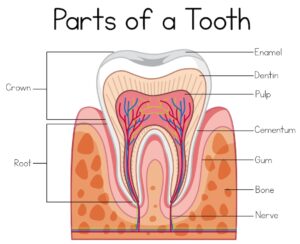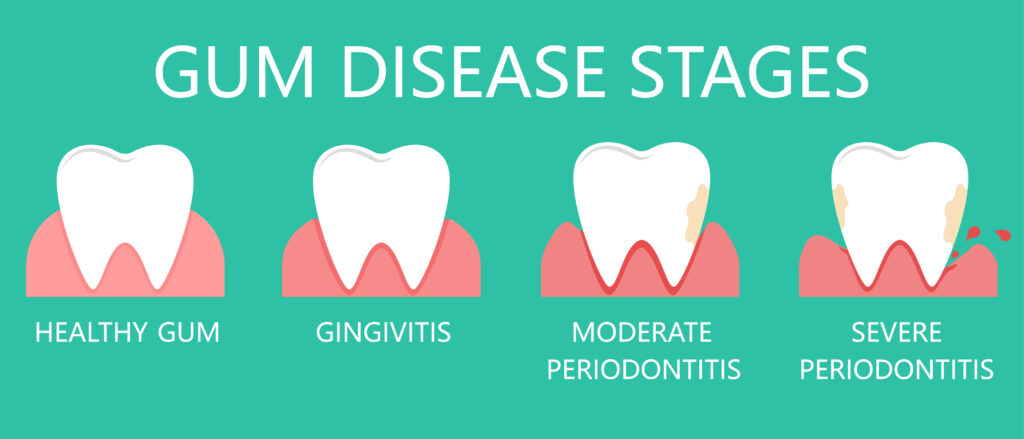
All About Our Gum
Gum are soft tissues that surround and support our teeth. Gums play a crucial role in maintaining oral health.
Structure of Gum
Our gums are connected to the alveolar bone. The alveolar bone is the part of our jawbone that holds our teeth in place. The gum forms a protective barrier around this bone, helping to keep it healthy and strong.
Our gum is also connected to the periodontal ligament. The periodontal ligament acts as a cushion between our teeth and the surrounding bone, allowing for slight movement when we chew or bite down. The gum plays a crucial role in maintaining the health of this ligament.
Lastly, let’s not forget that our gum is connected to our blood vessels. The gums have a rich blood supply, which helps to nourish them and keep them pink and healthy-looking.

Where is Gum?
Gums are located within the oral cavity of our mouth. Gums line the alveolar processes of our jaws and cover the roots of our teeth.
Next time you run your tongue along your teeth, take a moment to appreciate those resilient gums that keep everything in place.
Function of Gum
The gum, also known as gingiva, is an integral part of our oral cavity. It is a soft tissue that covers and protects the roots of our teeth. Gum plays a crucial role in maintaining oral health by providing a barrier against bacteria and preventing them from reaching the underlying structures.
So, next time you enjoy a piece of gum or brush your teeth, remember to give some love and attention to this important organ system in your mouth. After all, healthy gums are essential for maintaining a beautiful smile!
Medical Conditions Associated with Gum

Gum-related medical conditions can range from mild discomfort to more serious issues. Some common problems include gum disease, gingivitis, periodontitis, and even oral cancer. It’s important to pay attention to any changes in your gums and seek professional advice if needed.
When we talk about the pathophysiology of gum, we are referring to the gum tissue conditions that can lead to various gum diseases. One common condition is gingivitis, which is characterized by inflammation of the gums due to plaque buildup. If left untreated, gingivitis can progress to periodontitis, a more severe form of gum disease that affects not only the gums but also the underlying bone and ligaments.
Bacteria in dental plaque, our immune response, and other factors such as genetics and lifestyle choices influence the pathophysiology behind gum diseases. Poor oral hygiene practices, smoking, hormonal changes, certain medications, and systemic diseases like diabetes can all contribute to an increased risk of developing gum problems.
For early detection and effective management of gum diseases, we recommend regular dental check-ups and proper oral hygiene practices including brushing twice a day and flossing regularly. It goes without saying that a healthy lifestyle can help maintain healthy gums and prevent complications down the line.
Gum Disease Treatments
Taking care of our gums is just as important as taking care of our teeth.
When it comes to gum disease, there are various dental treatment options available. From non-surgical dental procedures like gum disease treatment to more advanced surgical interventions such as tooth extractions, we have got you covered.
Gum disease can be caused by a variety of factors such as poor oral hygiene, smoking, hormonal changes, and even genetics. We recommend addressing any signs or symptoms of gum disease early on to prevent further damage.
Remember, prevention is key! Regular brushing and flossing along with routine dental check-ups can help keep your gums in tip-top shape. And if you do happen to develop gum disease, don’t worry – modern dentistry has come a long way in providing effective treatments to restore your oral health.
Importance of Gum and your Health
Gums are key in maintaining good oral health. Gum acts as a protective barrier for your teeth and jawbone, keeping them safe from harmful bacteria and infections. Healthy gums also help keep your teeth firmly in place, preventing them from becoming loose or falling out.
Gums are also an indicator of overall health. Research has shown that gum disease can be linked to other serious health conditions such as heart disease, diabetes, and even respiratory problems. Taking care of your gums is not just about having a beautiful smile; it’s about taking care of your entire well-being.
So how can you keep your gums healthy? Regular brushing and flossing are essential to remove plaque buildup and prevent gum disease. It’s also important to visit your dentist regularly for check-ups and professional cleanings.
Remember, healthy gums equal a healthy smile and a healthier you! Don’t forget to give those gums some love and attention.

